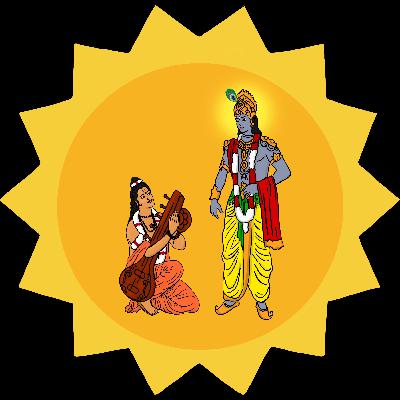Pragmatic Bhakti Sutra, Shlokas 35-37
Description
By renouncing sensory pleasures, we free our minds from distractions and attachments that can impede our spiritual progress. This allows us to focus more fully on our spiritual practices, such as meditation, prayer, and service, which can help us develop a deeper connection with God.
"The Allegory of the Cave" is a famous philosophical thought experiment presented in Plato's "Republic".
The story describes a group of prisoners who have been chained inside a cave their entire lives, facing a wall. They cannot move or turn their heads, and they can only see the shadows of objects that are being carried by people behind them. The prisoners come to believe that these shadows are the only reality that exists, as they have never seen anything else.
One of the prisoners is eventually freed and brought out of the cave, where he sees the sunlight for the first time in his life and goes through a transformative experience. Initially, he is dazzled by the brightness of the light and is unable to see anything clearly. However, as his eyes adjust, he begins to see the world around him in a new way, and he realizes that the shadows on the cave wall were only a distorted reflection of reality.
The freed prisoner's initial reaction to this revelation is shock and disbelief. He realizes that his entire perception of reality had been based on a false assumption, and he struggles to make sense of his new understanding. However, as he becomes more familiar with the outside world, he gains a greater understanding of the true nature of reality.
When the freed prisoner returns to the cave to try to convince the other prisoners of the truth, he is met with skepticism and disbelief. The other prisoners are so accustomed to the shadows on the wall that they cannot conceive of any other reality. They ridicule him and refuse to believe his claims.
The story encourages us to question our perceptions of reality and to seek a higher truth beyond the limitations of what we perceive using our senses. To do this, we must first get rid of our attachment to sensory objects and our need for sense gratification. Only then can we get freed from the distractions and false perceptions created by our senses.
The intellect decides and the mind follows. For example, if the intellect says that money is the most important thing in life, then the mind will run behind money all its life. Thus, if our mind is running behind various sense objects, then we should use our intellect to tell our mind that whatever our senses are running behind, they are not real. They are an illusion created by Maya and they are temporary and inferior to the only reality which is God and God’s divine Love. Then the mind will start running behind God. This is yet another use of Jnana or knowledge to get the mind to follow the path of Bhakti.
That is why Shri Krishna has spoken about the intellect in chapter 2 of the Bhagavad Gita:
व्यवसायात्मिका बुद्धिरेकेह कुरुनन्दन |
बहुशाखा ह्यनन्ताश्च बुद्धयोऽव्यवसायिनाम् || 41||
vyavasāyātmikā buddhir ekeha kuru-nandana
bahu-śhākhā hyanantāśh cha buddhayo ’vyavasāyinām
O descendent of the Kurus, the intellect of those who are on this path is resolute, and their aim is one-pointed. But the intellect of those who are irresolute is many-branched.


![Pragmatic Bhakti Sutras: The Divine Intoxication: Trading Endless Desire for Eternal Joy [Sutras 6 to 8]] Pragmatic Bhakti Sutras: The Divine Intoxication: Trading Endless Desire for Eternal Joy [Sutras 6 to 8]]](https://s3.castbox.fm/9a/19/f5/ce195a14eec5a9bf8ed00161fd410c1671_scaled_v1_400.jpg)
![Pragmatic Bhakti Sutras: The Art of Fulfillment [Sutra 5] Pragmatic Bhakti Sutras: The Art of Fulfillment [Sutra 5]](https://s3.castbox.fm/f0/a6/6a/54b978ab523eb84698397a4dd18c006211_scaled_v1_400.jpg)
![Narada Bhakti Sutras: Beginning the Journey of Divine Love [1 to 4] Narada Bhakti Sutras: Beginning the Journey of Divine Love [1 to 4]](https://s3.castbox.fm/64/ce/cc/c7b8125b6af7c68e8dbcee305bed4d75c0_scaled_v1_400.jpg)





